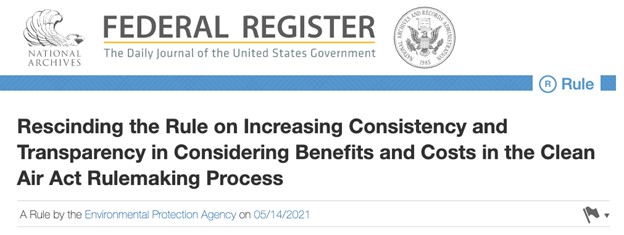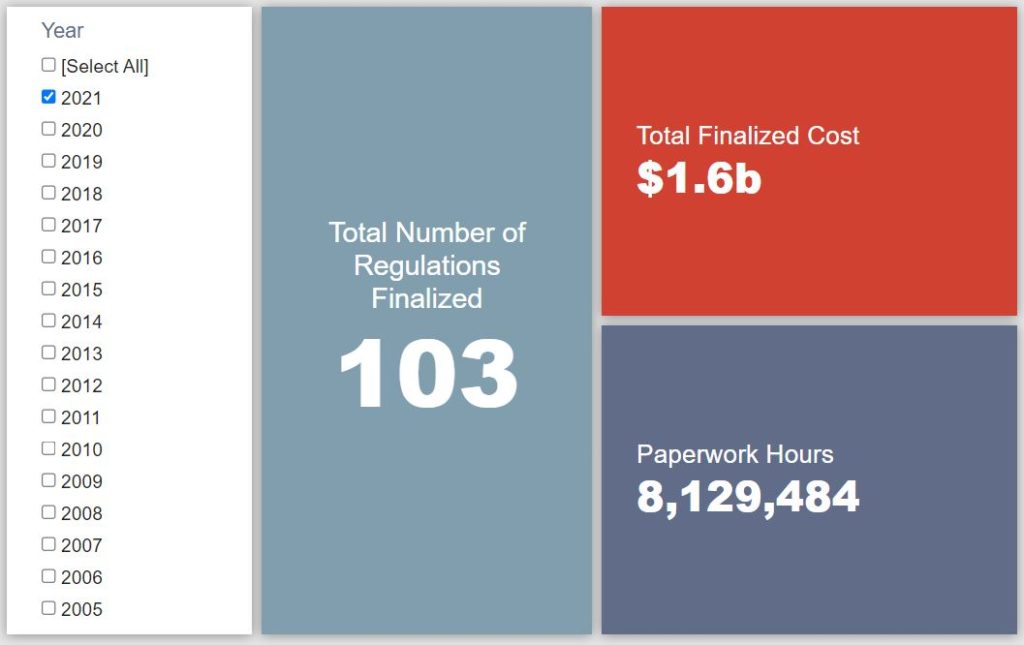Week in Regulation
May 17, 2021
COVID Continues to Leave Its Regulatory Mark
Even as broad safety guidelines regarding COVID-19 continue to loosen, federal agencies are still taking actions related to policy considerations surrounding the pandemic. Last week was a prime example of this. The most significant regulatory actions in terms of economic impact included a Department of Health & Human Services (HHS) rule on vaccination requirements in long-term care facilities and a Department of Education (ED) rule implementing the emergency financial aid provisions for college students included in the Coronavirus Aid, Relief, and Economic Security (CARES) Act. Across all rulemakings, agencies published $175.2 million in total net costs and added 2.3 million annual paperwork burden hours.
REGULATORY TOPLINES
- Proposed Rules: 48
- Final Rules: 60
- 2021 Total Pages: 26,588
- 2021 Final Rule Costs: $1.6 Billion
- 2021 Proposed Rule Costs: -$8.3 billion
NOTABLE REGULATORY ACTIONS
The most consequential measure of the week was the HHS rule regarding “COVID-19 Vaccine Requirements for Long-Term Care (LTC) Facilities and Intermediate Care Facilities for Individuals With Intellectual Disabilities (ICFs-IID) Residents, Clients, and Staff.” Leveraging its role as the regulator of such facilities receiving Medicare and Medicaid funding, HHS seek to – as the title suggests – establish a set of requirements covered facilities must adhere to regarding vaccination programs. This is driven by agency concern “that many groups at higher risk of infection, specifically residents and clients of LTC facilities and ICFs-IID, are not able to access COVID-19 vaccination.” HHS estimates that: 1) educating covered persons on vaccines, 2) administering the vaccine to the currently unvaccinated, and 3) providing documentation of these efforts will cost relevant facilities roughly $159 million over the next year.
The other notable action of the week in terms of economic impact was the ED rule on “Eligibility To Receive Emergency Financial Aid Grants to Students Under the Higher Education Emergency Relief Programs.” The rule redefines the term “student” under relevant statutes to open up the emergency aid program to a wider pool of applicants. This recategorization would also apply to funds provided under such subsequent legislation as the Coronavirus Response and Relief Supplemental Appropriations Act of 2021 and American Rescue Plan Act of 2021. ED estimates that the administrative requirements for students and their schools applying for the funds add up to roughly 1.3 million hours of paperwork at a total cost of $23.6 million.
CONGRESSIONAL REVIEW ACT UPDATE
On March 23, the first joint resolution of disapproval under the Congressional Review Act (CRA) of this term was introduced. CRA resolutions essentially seek to wholly rescind specific final rules within a set timeframe. The significance of these resolutions is discussed further here. In the interest of providing a public accounting of the potential economic impact of these actions should they pass, the American Action Forum (AAF) will provide a regular update of the rules being targeted and a concise summary of each rule’s purpose, economic impact, and why opponents may be targeting it. This past week, S. J. Res. 15, a CRA resolution addressing the so-called “True Lender” rule passed in the Senate by a vote of 52-47. It is the second CRA resolution to successfully pass through at least one chamber of Congress in this term.
TRACKING THE ADMINISTRATIONS
As we have already seen from executive orders and memos, the Biden Administration will surely provide plenty of contrasts with the Trump Administration on the regulatory front. And while there is a general expectation that the new administration will seek to broadly restore Obama-esque regulatory actions, there will also be areas where it charts its own course. Since the AAF RegRodeo data extend back to 2005, it is possible to provide weekly updates on how the top-level trends of President Biden’s regulatory record track with those of his two most recent predecessors. The following table provides the cumulative totals of final rules containing some quantified economic impact from each administration through this point in their respective terms.
![]()
The administrative burdens in the aforementioned rules drove a significant spike in the Biden Administration’s to-date paperwork total, putting it as the current leader in the clubhouse by roughly one million annual paperwork hours. The Obama Administration, however, saw the largest cost increase, jumping by roughly $1.4 billion largely thanks to a motor vehicle safety rule. Meanwhile, the second week of May during President Trump’s first year saw no recordable new regulatory activity.
THIS WEEK’S REGULATORY PICTURE
This week, the Environmental Protection Agency (EPA) rescinds one of the Trump Administration’s most prominent regulatory reforms.

On May 14, the EPA published an interim final rule (IFR) rescinding a 2020 Trump Administration rule that set in regulatory code guidelines for benefit-cost analysis for Clean Air Act rules. The Biden EPA acted under the direction of one of the president’s day one actions, Executive Order 13990, which asked EPA to review and consider rescinding specified EPA rules.
The Trump Administration rule’s main reform was to reduce the impact of co-benefits on the benefit-cost calculation. Co-benefits are incidental benefits not directly related to regulating a targeted pollutant and have been used in the past to justify expensive regulations that would not have been net-beneficial if only considering the impact of the rule on the targeted pollutant. The Trump rule called for EPA to identify co-benefits, but the value of those was to be separated from the direct benefits and not used to drive a regulatory decision.
In its IFR, the Biden EPA identified six reasons why it says the rule should be rescinded, including that the rule limited the agency’s ability to use what it views as the best science, that it was unnecessary because EPA conducts benefit-cost analysis on Clean Air Act rules already, and that the Trump Administration failed to offer a “rational basis” for the rule. While most of EPA’s reasons are opinion rather than fact, the rule did not limit EPA’s ability to rely on the best science, it merely prescribed steps for how that information should be evaluated in the benefit-cost context.
Though EPA issued the rescission as an IFR, it appears that it does not intend to follow up the public comment period with a new rule on how EPA should use certain data in its analyses. Rather, it plans for its final rule to permanently rescind the Trump Administration rule.
TOTAL BURDENS
Since January 1, the federal government has published $6.6 billion in total net cost savings (with $1.6 billion in new costs from finalized rules) and 3.6 million hours of net annual paperwork burden reductions (with 8.1 million hours in increases from final rules).












